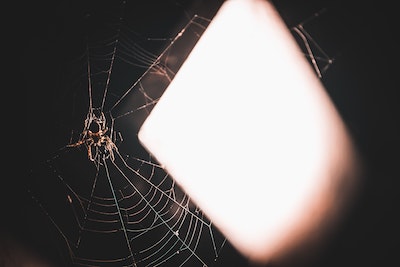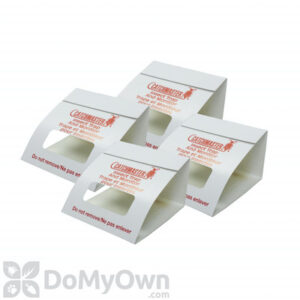Methods That Work to Draw Spiders Out of Hiding
If you’re like me and you’re terrified of spiders, killing them and luring them out of your house is one of your top priorities. You’ve got your tried and true methods of killing spiders – stepping on them, swatting them, using a cup and plate to capture them, etc. But, luring them out of hiding can be a little more challenging. For one thing, you don’t have all day to sit and wait for a spider to come out, and another thing – they aren’t likely to come out while you’re sitting there! In order to help you rid your house of as many spiders as possible, here are some methods for luring spiders out of hiding.
How do you draw spiders out of hiding? Luckily, for those of us who fear spiders, there are quite a few ways of luring them out of hiding (so we can boot them out of our house!) These are some of the best methods, that actually work, for drawing spiders out of hiding:
- Use prey to coax the spiders to come out and eat
- Pluck the web to create vibrations
- Starvation and removing of webs
- Spray water near the hiding spot
- Set up spider traps
Spiders are not typically welcome visitors in our homes, so we want to make sure we know how to get rid of them. Let’s talk about how to implement these methods and what makes them work.
Why Do Spiders Hide?
Before we talk about how to lure spiders out of hiding, let’s understand why they hide in the first place. Most spiders are attracted to dark, warm, sometimes moist areas that have access to a food source. This means they will seek out closets, basements, dark corners, and areas under furniture and cabinets as homes because they are dark and warm.
Attics, garages, and air vents are other sources where you’re likely to find a few hidden spiders. As long as they can find some food, spiders may spend their whole life inside hidden away from you – which is kind of a scary thought.
Cleaning regularly helps to eliminate these comfortable homes for spiders and make them reconsider their habitat. Vacuuming and dusting help to get rid of their webs and clean up anything hiding in the carpet.
1. Use Prey to Coax a Spider Out of Hiding
Focusing on the natural instincts of a predator is always a good method of drawing them out. Spiders feed on prey like crickets, ants, and other insects. If a spider is hiding from you, their hunger needs will eventually force them out of that spot at some point.
When using prey, simply line the spider snack along the edge of where the spider is hiding. Do your best to be quiet and as motionless as possible so as not to disturb or alert the spider. As soon as he comes out to take a bite, step on him or capture him in a jar.
If a spider is hiding out there is a good chance there is a food source nearby – which would lead to other exterminator needs. But, if there is no other food source, the spiders will either move to another location or die from starvation. A little snack to entice them out of hiding will get rid of the spider, but maybe not the other food source (another problem for another day).
2. Pluck the Web to Create Vibrations
Spiders spin webs to help them capture prey. Vibrations in the web alert a spider that they may have caught something – drawing them out of hiding and allowing you to capture them.
When plucking the web, you need to be careful that you don’t do it too strong and break a string or warn the spider that it’s something other than prey. Using something light and thin like hair or string is all it takes to create vibrations.
While this method is effective and easy to use, you may not always have the opportunity to use it if the spider is hidden in a hole or location where a web is not accessible. Luckily, there are many other methods you can try!

3. Starvation and Removing Webs
Spiders typically only inhabit a certain area or hide because there is a food source nearby or they need a shelter. By removing the food source and keeping your house clean and clear of other insects, you should greatly reduce the chances that a spider will find their home inside your home.
If spiders have located a food source, you need to determine what that food source is and how to get rid of it first. This could mean calling an exterminator or spraying for insects.
Once the food source is gone, the spider will either relocate or die from starvation.
Keeping a house clean is not the easiest thing in the world. There are lots of nooks and crannies, corners and high ceilings, clutter, and closets – all are really good spots for a spider to spin a web.
Though it’s not easy to keep up with, creating a regular cleaning, or even just dusting, a schedule can help you get rid of webs and eliminate comfortable spider homes.
4. Spray Water Near the Spider’s Hiding Spot
An unusual method that many people may not consider is using water to lure spiders out or trap them. People are more likely to think about using hairspray or insect spray when trying to kill spiders – but just water is actually more effective against spiders.
Most spiders are extremely inconvenienced by water, they either can’t survive if it’s too deep or it can be too invasive for their home. Spraying or dropping water into the hole where the spider is hiding will often cause them to come out. You could even use water to drown the spider as well, effectively getting rid of their home and hopefully, anything else that may have found its way inside.
5. Set Up Spider Traps
Though this is a method that is considered more as a means of killing spiders, setting up traps can also lure them out of hiding. The best spider trap is something you use to catch mice and cockroaches – glue traps.
Flat sheets with no raised edges that are extremely sticky will trap any spider or insect that comes across them. Using traps won’t necessarily draw a spider out, but it lets you go on with your business and increases the chances that you will catch the spider when you’re not looking.
You can also use these glue sheets as an addition to setting out prey for the spider. When the spider comes out to take a bit of its snack, it’ll get stuck and your problem will be solved.
How to Use the Spider Trap
Related Questions
Are Spiders That Hide in My House Dangerous?
Not typically. Most spiders that find their home inside of yours are innocent and will not harm you. (That doesn’t mean they don’t scare you though.) Depending on where you live, there is a chance that some dangerous spiders could find their way in, but the likelihood is not very high.
In the United States, only two spiders that could potentially find their way inside your home are considered to be dangerous: black widows and brown recluses. Black widows are more likely to be found outside and the brown recluse is just that – a recluse.
Encountering these spiders in your home is not likely and even less likely to cause you harm; however, it should prompt you to have a professional take a look and determine that there aren’t any infestations you should be worried about.
When Should I Call an Exterminator for Spiders that Hide in My House?
Chances are, you’re more likely to notice spiders as the seasons change – they will either be finding their way inside for shelter from rain, snow, or heat. While this is true, indoor spiders are a year-round occurrence and don’t just disappear. When you start noticing them more than usual, it may be time to call a local professional.
One thing that helps is to set some traps out before your seasonal insecticide treatment. This will capture any spiders and insects that get forced out and can help you determine if there’s a bigger problem. At the same time, if a spider problem is big enough for traps to actually be effective, it also means that it’s time to call a professional.
Continuously seeing spiders on the walls, near windows, in the attic, etc. means that you could have an issue or infestation and a professional should be consulted. The best way to prevent large infestations is to have an exterminator come out and do an insecticide treatment seasonally.

